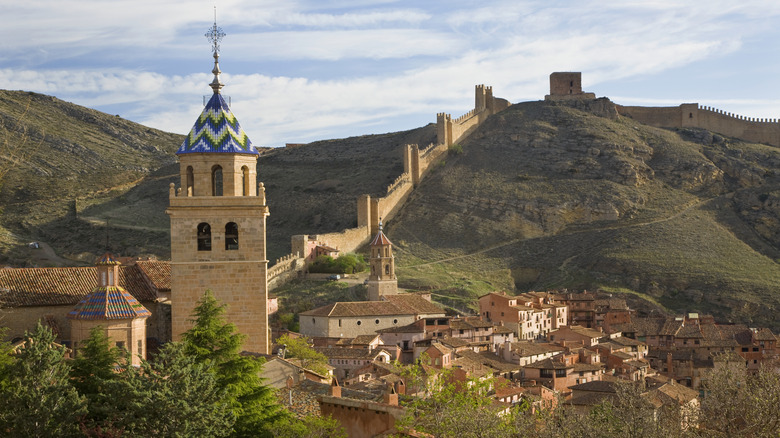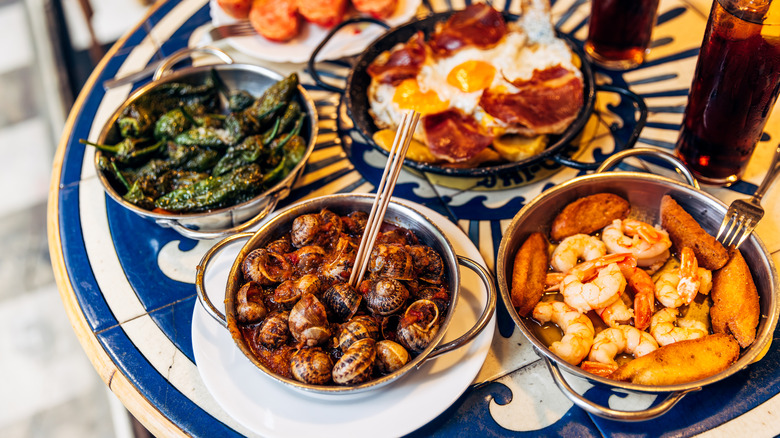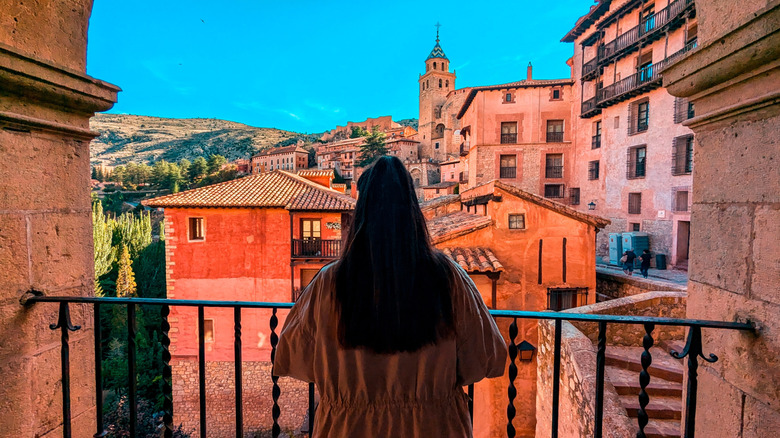Spain's 'Most Beautiful Village' Offers Immaculate Food And Is Always Overlooked By Tourists
Spain has no shortage of gorgeous, small towns. Many of these destinations are a great way to immerse yourself in Spanish culture, away from the tourist traps of bigger cities like Madrid or Barcelona. While experiencing urban life is great, renting a car or taking public transit to other parts of the country can offer you fantastic insight into Spanish art, history, and way of life. One excellent place to go is Albarracín, a small town of less than 1,000 inhabitants with thousands of years of history. Beyond this, Albarracín was voted the most beautiful village in Spain in 2018 (via El País). But the town has even more to offer than just a photo opportunity; it's also a lively spot with excellent food and fascinating sightseeing.
Albarracín is located in the Teruel province, in the region of Aragón in eastern Spain. It's about two hours from the city of Valencia, one of the largest historic centers in Europe. The simplest and best way to get to the town is to rent a car and drive there from any major city. If you prefer to travel by public transit, you can also find a bus or train to the nearby city of Teruel from Valencia, Madrid, or Barcelona and then transfer to another bus to Albarracín. The small town is somewhat far for just a day trip, but luckily, it has quite a few hotels, many in a very affordable range. Although it's not known very well by international tourists, plenty of Spanish travelers still go to Albarracín, especially during the summertime.
Albarracín is an ideal getaway for foodies
Spanish medieval towns offer excellent food against a backdrop of gorgeous scenery, and that is certainly true in Albarracín. The town is full of restaurants serving up both traditional and non-traditional foods, especially tapas and local delicacies. Foodies can easily find hearty, comforting dishes like migas, gazpacho, and stews cooked with local produce such as beans and potatoes, along with meats like ham, rabbit, lamb, and river trout. Certain dishes have a Muslim influence since the area was under Muslim rule during the Middle Ages; these include classic Albarracín desserts like almojábanas (a sweet, fluffy type of doughnut). Cheeses made with goat's and sheep's milk are also plentiful in the area.
If you're looking for authentic tapas, you can easily find taverns like La Despensa, Taberna Albarracín, or Taba, which serve endless variations of classic Spanish small plates. There are also plenty of other restaurants around town (though you may encounter a few that are closed during the wintertime). Albarracín also becomes very lively during festivals and events, including the Jornadas Gastronómicas de las Setas in the fall, a celebration of local mushrooms and truffles that grow around the Sierra de Albarracín area, which includes other small towns close by. If you visit on Saints Days and holidays, such as San Antonio Abad (January 17), you will also likely run into town-wide celebrations.
There are plenty of historical and natural wonders in Albarracín
Albarracín is famous for its views of the mountains and the Guadalaviar River. The town is surrounded by plenty of places to go climbing and bouldering on its red sandstone rocks as well as scenic hiking trails to get an up-close-and-personal look at Mother Nature. Popular places to hike are the various waterfalls in the area, including El Salto de San Pedro in el Vallecillo and Cascada de Calomarde. Moreover, the Albarracín Community Mycological Park is the perfect place to go mushroom hunting, and the town itself is located in the middle of Albarracín Cultural Park.
The cobblestone streets of Albarracín contain centuries of history, from its ancient roots to medieval times to the Spanish Civil War. One of the more popular destinations is the Catedral del Salvador, which was built in the 16th century and beautifully renovated after a period of wars and unrest (including colorful, new tiles on the roof of its bell tower). Walking along the Murallas de Albarracín — the Medieval walls around the town — offers the best panoramic vistas, especially Torre del Andador (the highest viewpoint in town).
If you want to take deeper dives into the town's history, visit the Museo de Albarracín to discover its archeological and historical past. Do note that since the town is so small and fairly isolated, most residents reportedly do not speak English and most tours will be in Spanish. If you'd like to plan a trip to Albarracín, check out our guide on Spanish words and phrases to know before visiting Spain.


